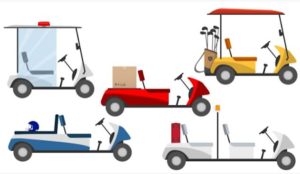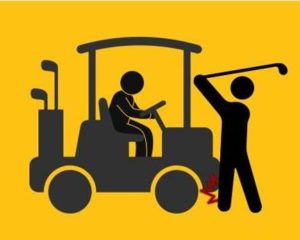A utility cart is a small motorized vehicle such as a cushman, gator, golf cart, club car etc. that are used to carry supplies, equipment, products, goods, injured athletes, etc. Although, they are smaller than regular cars they can still carry large and heavy loads and reach high speeds, enough to cause an accident or seriously injure someone. If you work in an industry that uses utility carts, you should be taking precautions every time you drive.
Pre-Operation Inspection:
Since there are many different types of utility carts, it is important to always be familiar with the operations of that specific utility cart. You can do this by having a pre-operation checklist:
- Check the manual
- Check the fuel or battery charge
- Check the tires
- Check the weight/load capacity
- Check the horns, lights, and alarms
- Last but certainly not least check for safety equipment
Types of Accidents
- Cart vs Cart – these kinds of accidents tend to happen when drivers get distracted.
- Cart vs Pedestrian – pedestrians should always have right of way.
- Cart vs Other Motor Vehicle – to avoid these accidents it’s important to obey all traffic rules & not block driveways.
- Single-cart – A lot of accidents can occur when exceeding the weight limit. Be mindful of the maximum persons in a utility cart, when cart is over loaded with passengers or cargo it is harder to stop and the cart is more likely to flip.
Safety Practices to Follow:
In general you should be following all parking regulations and traffic laws. Although this is a smaller vehicle and some utility carts have a roof it is still important to remember that unless the vehicle is DOT approved and licensed for such use it should not be on public roadways. It is important to also keep an eye out for pedestrians and other vehicles, and follow general driveway regulations. Heavy loads should also not be extended excessively beyond the sides of the cart.
New Jersey State Regulations
In accordance with N.J.S.A. 39:4-31.2, Low Speed Vehicles (LVS) operated on any public road or highway in the state shall be maintained in proper condition and comply with the following equipment requirements and standards:
- Adequate brakes to control the movement of the vehicle;
- An odometer;
- A speedometer;
- The original manufacturer’s VIN die-stamped on the body and/or frame, engine or motor of the vehicle; and
- A safety information decal provided by the manufacturer which must be in a conspicuous place on the rear of the vehicle displaying “25 mph Vehicle”.
Personal Injury Lawyers in New York & New Jersey
If you, or someone you know, have suffered a personal injury in the New York or New Jersey area because due to the negligence of someone not using a company’s vehicle properly, the law firm of Ginarte Gonzalez Winograd L.L.P., wants to hear from you. It is possible that the employer did not issue the proper training for these vehicles or that safety equipment wasn’t being used at the time.
Contact us now to find out how we can help you get the money you deserve at 1-888-GINARTE (1-888-446-2783) today. You can also fill out our online form if you prefer.
Resources:
1.) https://learnatvivid.com/five-minute-safety-training?namesource=Email%20Campaign&leadtype=MQL&channel=Email&utm_term=Train%20Your%20Employees&utm_campaign=Utility%20Cart%20Safety%20in%205%20Minutes&utm_content=email&utm_source=Act-On+Software&utm_medium=email
2.) http://www.state.nj.us/mvc/Vehicle/LowSpeed.htm


